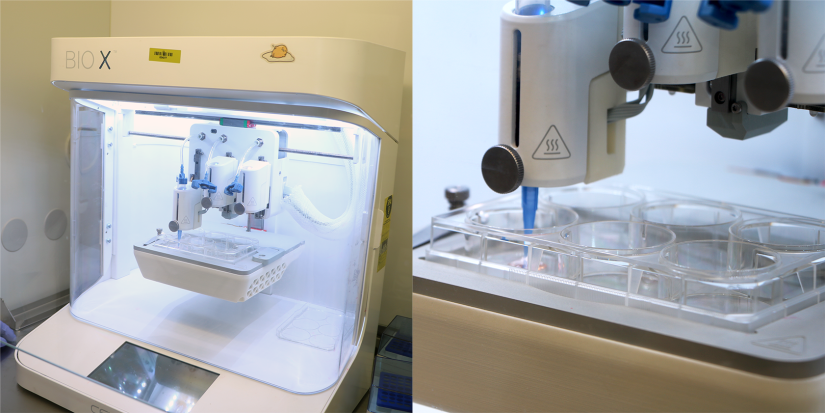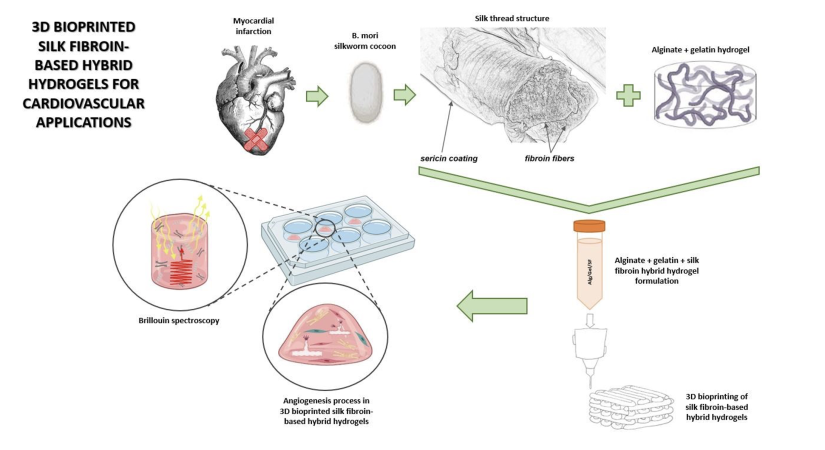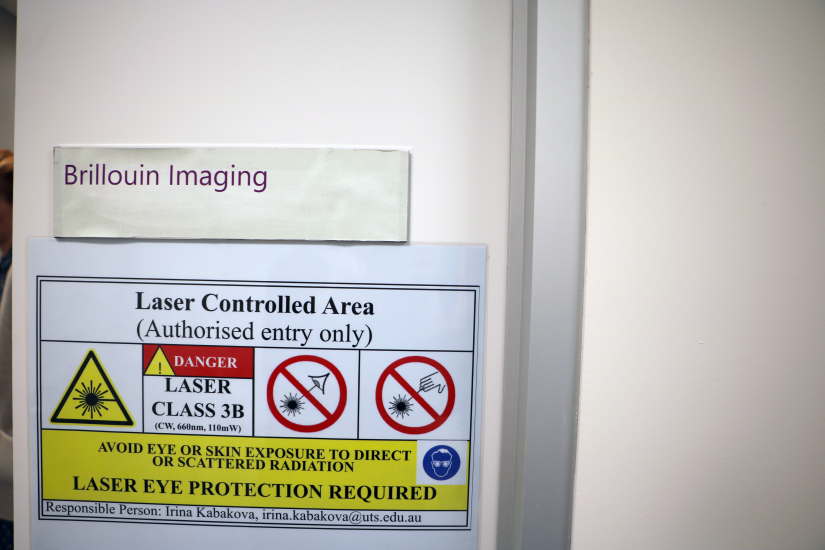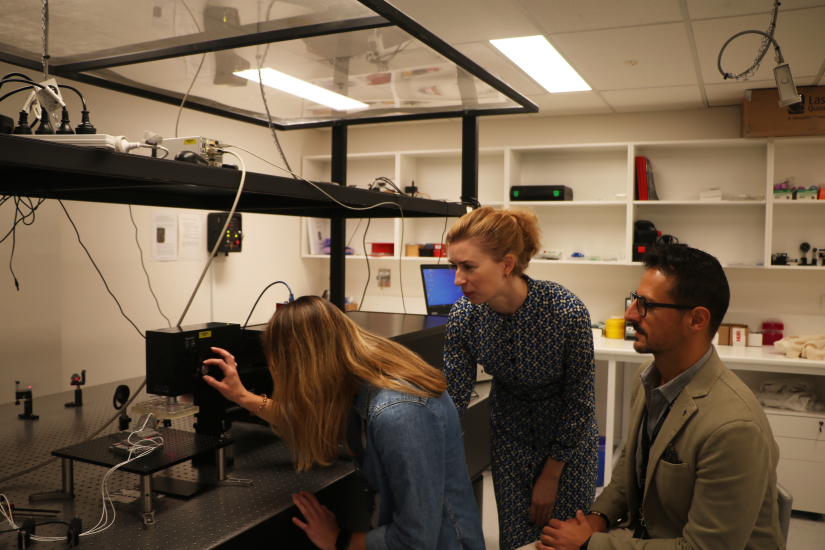A multidisciplinary team of researchers from UTS, consisting of biologists, bioengineers, and physicists, are combining 3D bioprinting technology with patient-derived stem cells to create bioengineered heart tissues.

Irina Kabakova, Carmine Gentile and Laura Vettori in the Advanced Biofabrication Facility at UTS
We reached out to a multidisciplinary team of UTS researchers consisting of Dr Carmine Gentile, Associate Professor Irina Kabakova, and Laura Vettori to find out more about their groundbreaking work and innovative approach to 3D bioprinting of cardiovascular tissue.
What is the innovative approach being used?
The innovative approach employs ground-breaking technologies and multidisciplinary techniques which can be divided into two major parts:
- Bioengineering of on-demand cardiac tissues with patient-derived stem cells, natural biomaterials, and 3D bioprinting technology, with the ultimate goal for personalised testing of drugs in a tube and for heart repair for patients, and
- Using state-of-the-art Brillouin microscopy to confirm that bioengineered heart tissues mimic native heart tissues for desired requirements in terms of chemical, mechanical and pathophysiological properties.
Who is a part of this multidisciplinary team?
The multidisciplinary team comprises experts in cardiovascular bioengineering, biomaterials, medicine, and pathophysiology. The team includes researchers from UTS, the University of Sydney, and other institutions across Australia, Europe, Asia, and America.
The team from UTS is led by Associate Professor Irina Kabakova (UTS School of Mathematical and Physical Sciences), Dr Carmine Gentile (UTS School of Biomedical Engineering/FEIT) and PhD candidate Laura Vettori (UTS School of Biomedical Engineering/FEIT).
This clever team of innovative scientists and engineers share a very important common goal: to create a robust and functional cardiac tissue. Their work is crossing barriers between disciplines as they apply approaches from different areas of science and technology to find new and innovative approaches to solving problems.
New solutions in science and health care that have potential to transform the future of our society usually come from combining great ideas across many different disciplines and a collective of experts that can bring these ideas to life.
Associate Professor Irina Kabakova
Why do we need 3D bioprinting of cardiovascular tissue?
Cardiovascular tissue is a specialized type of tissue that makes up the heart. The tissue of human hearts in adults does not have regenerative capacity following a heart attack or similar ischemic events. When the tissue of our hearts is damaged, such as following a heart attack, the cardiac cells that make up the tissue die. This results in irreversible damage to the myocardium and the formation of scar tissue, leading to heart failure, one of the main causes of mortality globally.
Heart transplantation is the primary treatment for patients with heart failure. However, with transplantation comes the associated risks of transplant rejection, infection and inflammation of blood vessels. There are also more patients with heart failure in need of a transplant then there are heart donors. As a result, transplantation may not be a viable option for many patients with heart failure and so it is necessary to look for viable alternatives to heart transplantation.
At the centre of the search for alternatives to heart transplantation for patients with heart failure is finding a way to replace the damaged tissue with a suitable biomaterial that mimics cardiovascular tissue. Producing these biomaterials requires the use of a range of different bioengineering methods and technologies such as 3D bioprinting being utilised by the team of UTS researchers.
How does 3D bioprinting of cardiovascular tissue work?
There are a number of approaches to cardiac tissue bioengineering. 3D bioprinting technology has emerged in the last decade as one of the most prominent methods.
The process involves mixing cardiac cells with gel materials (‘hydrogel’) that provide the cells with the required structural support and mechanical integrity to assist in the delivery of oxygen and nutrition to the cells.

3D bioprinter in Advanced Biofabrication Facility at UTS
What is the problem that needs to be addressed?
A major problem with bioprinted tissues generated by other groups is their tendency to degrade rapidly, thus limiting their utility as a long-term treatment option post-transplantation. The team of UTS researchers has sought to address this problem through a natural polymer (silk fibroin) to enhance integrity and durability of the hydrogel in order to extend the lifespan of the tissue and to promote formation of blood vessels for better delivery of oxygen and nutrients. Silk fibroin is a natural protein extracted from the silkworm thread and after being used for many years in the textile industry, it revealed to have great features to be used as hydrogels for cardiovascular tissue engineering and 3D bioprinting applications. Beside the fact silk fibroin hydrogels features can be easily modify, it also presents low immunogenic responses in the human body, so to avoid tissue rejection after transplantation of the new engineered tissue.

Schematic overview of 3D bioprinted silk fibroin-based hybrid hydrogels for cardiovascular applications
Silk fibroin is a natural protein extracted from the silkworm thread and after being used for many years in the textile industry, it revealed to have great features to be used as hydrogels for cardiovascular tissue engineering and 3D bioprinting applications. Beside the fact silk fibroin hydrogels features can be easily modify, it also presents low immunogenic responses in the human body, so to avoid tissue rejection after transplantation of the new engineered tissue.
PhD Candidate Laura Vettori
The team analyses and refines the mechanical properties of the models by applying Brillouin microscopy, an innovative characterisation technique only possible at UTS, which provides critical microscopic information on the elasticity and stiffness of the cardiac tissues without need for harmful additives, radiation or mechanical loads. Altogether, the novel material engineering, tissue fabrication and characterisation make the approach for engineering cardiac tissue highly unique, innovative and successful.

Brillouin imaging lab at UTS
Brillouin microscopy is a relatively new technology that uses light to assess mechanical properties of materials at the microscale. The microscopy system that we have at UTS is so far the only system of its kind in Australia.
Associate Professor Irina Kabakova
What are the next steps?
The team has validated their approach in preclinical studies that demonstrate the feasibility of the technology and the potential for long-term treatment. Thanks to the support of the clinical team members (cardiac surgeons and cardiologists at Royal North Shore Hospital) the team is working on the best approach to quickly translate this technology in a safe way from the bench to the bedside.

Irina Kabakova, Carmine Gentile and Laura Vettori in Brillouin Imaging lab at UTS
Our multidisciplinary team is uniquely composed of experts in areas that are critical for the success of such an ambitious project. Thanks to the support received by UTS and other supporters within Australia and globally we are fast approaching our goals. This enables us to support students, such as current UTS PhD candidate Laura Vettori, who are the next generation of scientists and the best hope for the future of cardiovascular research and health.
Dr Carmine Gentile
Read more about this research in a recent article published in Biofabrication.

